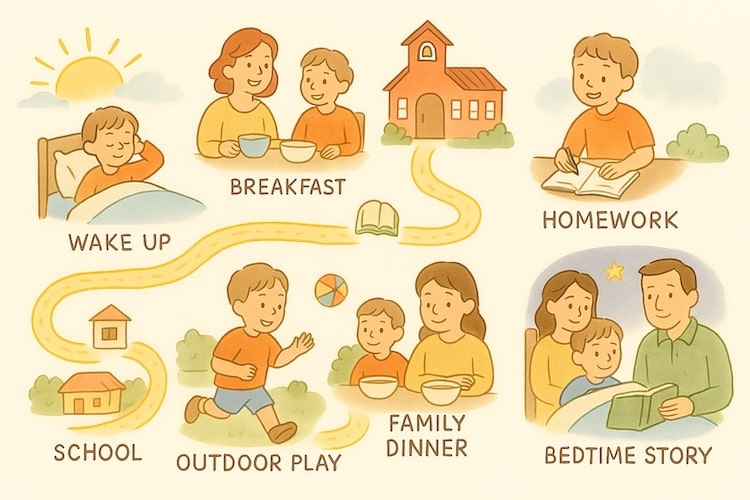Mental Health Improvement for Kids: A Practical, Gentle Guide for Parents
Why Kids’ Mental Health Needs Our Full Attention
Kids don’t just “bounce back” from everything. They feel scared, lonely, embarrassed, angry and overwhelmed just like adults do — they just have fewer words and fewer tools to explain it. Childhood and adolescence are periods of huge brain growth and emotional development, and what happens in these years shapes mental health for life.
Global health experts say this is the time when children build the habits that protect their mental well-being: good sleep, regular movement, coping skills, healthy friendships and the ability to manage big feelings. When those pieces are missing, or life becomes too stressful, kids’ mental health takes a hit.
We’re also living in a time where more children and teens are struggling. Large surveys show rising levels of sadness, anxiety and mental health conditions among young people worldwide. In some studies, around 1 in 5 adolescents has a mental health condition, and a big share of high-school students report persistent feelings of sadness or hopelessness.
The good news: parents and caregivers have huge power here. You don’t need to be a therapist. Small, consistent things you do at home — how you talk, how you handle routines, how you respond when your child melts down — can genuinely protect and improve your child’s mental health over time.

What “Good” Mental Health Looks Like in Kids
Sometimes parents only think of mental health when something is clearly wrong. But knowing what healthy emotional life looks like makes it easier to notice when a child is drifting off track.
A mentally healthy child will still have tantrums, tears and bad days — that’s normal. But over time, you tend to see things like:
- Curiosity: They want to explore, ask questions and learn new things.
- Connection: They smile, laugh and show affection with trusted adults and kids.
- Recovery after stress: They get upset but can calm down again with support.
- Playfulness: They can enjoy play, hobbies, and downtime.
- Growth: They slowly develop skills to handle frustration, disappointment and change.
Large national surveys show that many young children who are doing well emotionally are affectionate with caregivers, bounce back when things don’t go their way, and show strong curiosity and joy.
Mental health isn’t about being “happy all the time.” It’s about having enough support, skills and safety so that when life throws something difficult at your child, they can struggle and recover — instead of getting stuck.
Why So Many Kids Are Struggling Today
Kids today grow up in a world that can feel like too much, too fast. A few things often pile up:
- Academic pressure and competitive schooling
- Social media and screens constantly comparing their lives to others
- Bullying (both offline and online)
- Family stress, money worries, or relationship conflict
- Big world events, scary news and uncertainty
Studies show that mental health challenges in youth have been increasing over recent years, especially symptoms of anxiety, depression and serious thoughts of self-harm.
It’s not your “fault” as a parent. But you are one of the strongest protective factors your child has. A calm, caring, predictable home can soften the impact of everything happening outside.
The Everyday Foundations of Strong Mental Health
Think of your child’s mental health like a table. You don’t want it balancing on one wobbly leg. These are the main “legs” that keep it steady: connection, routines, sleep, movement, wise screen use, and a safe, encouraging environment.
1. Connection First: Your Relationship Is the Real “Therapy”
Children build emotional strength inside a safe relationship. When they know “I am loved, I am heard, I am safe even when I mess up,” their brain learns to calm down more easily.
Helpful habits:
- Daily check-ins: Even 10–15 minutes of one-on-one time each day where you’re fully present — no phone, no multitasking. Let your child choose the activity.
- Name and validate feelings:
- “You look really disappointed. That test was important to you.”
- “It makes sense that you’re angry. I would feel angry too.”
- Be their “calm anchor”: When your child is a storm, you can’t be a second storm. Take a breath, lower your voice, and be the grown-up nervous system they can borrow.
Research shows that positive parenting behaviors, strong parent-child relationships and emotionally safe homes help children develop the brain-based skills they need to manage emotions and stress in healthy ways.
This doesn’t mean being perfect. It means noticing when you snap, apologizing, and trying again. Repair is incredibly powerful for kids.
2. Routines and Boundaries: The Nervous System Loves Predictability
Kids feel safer when life is somewhat predictable. Routines don’t need to be strict, but simple patterns help:
- Similar wake-up and sleep times daily
- Regular meal and snack times
- A small after-school rhythm (snack → play → homework → downtime)
- A simple bedtime routine (bath, story, chat, lights out)
When kids know what’s coming next, they fight less and worry less. Their body and brain can relax because there’s a sense of “Okay, I know how my day usually goes.”
Routines aren’t just about efficiency. They’re a quiet form of emotional protection.

3. Sleep: The Hidden Superpower
A tired child is not just “moody.” Sleep is deeply tied to emotional regulation, focus and resilience. Studies link good sleep, regular bedtimes and enough rest with better mental health in kids, while chronic sleep deprivation is associated with more anxiety, irritability and low mood.
What helps:
- Keep bedtimes consistent, even on weekends as much as possible.
- Turn off screens 60–90 minutes before bed; bright light and exciting content can delay sleep.
- Create a wind-down routine: dim lights, warm bath, gentle stretching, quiet reading or cuddles.
- If your child worries at night, try a “worry notebook” earlier in the evening where they can draw or write their worries and then “close the book” until morning.
You’ll probably notice: when sleep improves, behavior, mood and school focus often improve as well.
4. Movement and Outdoor Play
Kids are built to move. Exercise isn’t just good for bones and muscles; it’s strongly connected to better mood, less stress and better mental health in children and teens.
You don’t need fancy sports clubs (though they can help). Everyday ideas:
- Walk, scooter or bike together when possible
- Turn on music and have silly dance breaks at home
- Go to the park and let your child climb, run, and play freely
- Family games: football, catch, frisbee, skipping rope, hide-and-seek
Studies during and after the pandemic show that when children move more and sit less, their mental health tends to be better, even under stress.
5. Screens: Not the Enemy, But Needs a Fence
Screens aren’t going away. The goal isn’t zero; it’s balance. Too much recreational screen time, especially late at night, is linked with poorer sleep, less physical activity and higher health risks over time. Those things all feed into mental health.
You might try:
- Screen-free zones: no phones at the dinner table or in beds
- Screen-free times: one technology-free hour before bedtime
- Co-viewing with younger kids so you can talk about what they see
- Clear boundaries around social media use for older kids
The most important piece? Model it. If kids see us constantly glued to a screen, every rule feels unfair. When they see us putting our own devices down, it’s easier for them to follow.
6. A Safe, Encouraging Environment
Children’s mental health is strongly shaped by their environments: home, school and community. Supportive, non-violent homes and schools reduce risk and build resilience.
Helpful things here include:
- Avoiding shaming language (“What’s wrong with you?”)
- Using firm but kind discipline (clear limits, but no humiliation)
- Noticing small strengths and praising effort: “You kept trying even when that was hard.”
- Keeping open communication with teachers and school staff
- Watching for bullying and taking it seriously
Some research also shows that regular school attendance itself can be protective, and long-term absence is linked to poorer mental health for many children.
Teaching Kids to Talk About Their Feelings
Kids aren’t born knowing how to say, “I feel anxious because I’m worried my friends don’t like me.” They show it through behavior — clinginess, anger, stomachaches, silence. Part of mental health improvement is teaching them the “language of feelings.”
Make Feelings Normal, Not Scary
- Use feeling words in daily life: “I’m frustrated that the traffic is so slow,” or “I feel proud of how we all helped today.”
- Read stories and ask: “How do you think this character feels right now?”
- For younger kids, use simple emojis or faces: happy, sad, angry, scared, excited, worried.
Create Simple Check-In Rituals
You can do:
- “Rose and thorn”: one good thing and one hard thing from the day
- A 1–10 scale: “If 1 is the worst day ever and 10 is an amazing day, where are you tonight?”
- Draw feelings: “Show me your day in pictures.”
The point isn’t to fix everything instantly. It’s to send the message: Your feelings matter here. I can handle them. You don’t have to hide.

Building Resilience and Coping Skills
Resilience is not about “toughening kids up.” It’s about helping them feel capable of facing challenges with support.
You can gently grow resilience by:
1. Letting Them Try, Fail and Try Again
- When something is difficult, resist jumping in too quickly.
- Coach them instead: “What’s one small step you could try?”
- Praise effort, not just results: “I loved how you kept going.”
This helps children build a sense of competence instead of learning “Someone else will always rescue me.”
2. Teaching Simple Coping Tools
Coping skills don’t need to be fancy. You can practice when your child is calm, so they’re easier to use when emotions are high:
- Breathing: “Smell the flower, blow out the candle” (slow in through the nose, out through the mouth).
- Grounding: “Name 5 things you can see, 4 you can touch, 3 you can hear…”
- Movement: Jumping jacks, shaking arms, squeezing a stress ball.
- Comfort items: A favorite toy, blanket or small object they can hold.
3. Supporting Friendships and Community
Belonging is a big part of mental health. Encourage:
- Low-pressure playdates or meetups
- Team activities, clubs, sports, or creative classes
- Time with extended family or trusted adults
Strong relationships outside the immediate family are another protective layer for kids.
Early Warning Signs: When to Pay Closer Attention
All kids have rough patches. But some patterns deserve extra attention, especially if they last for weeks, get worse, or interfere with daily life at home, school or with friends.
Professional organizations highlight signs like:
- Sadness or irritation that lasts most days for two or more weeks
- Big changes in social behavior: withdrawing, avoiding friends, refusing activities they once enjoyed
- Talk of death, self-harm, or “I wish I wasn’t here” (this always needs immediate professional attention)
- Out-of-control behavior that puts them or others at risk
- Frequent physical complaints (stomachaches, headaches) with no clear medical cause
- Major sleep changes: sleeping far too little or too much, frequent nightmares
- Strong difficulty concentrating, sudden drop in school performance
- Regression: going back to much younger behaviors (bedwetting, baby talk, clinginess) for a long period
If you’re seeing these signs, it does not automatically mean your child has a formal mental illness. It does mean it’s time to talk to your child’s doctor, teacher or a qualified mental health professional. Early support can prevent problems from becoming bigger and longer-lasting.
What to Do If Your Child Is Already Struggling
If you’re reading this because things are already hard at home, you’re not a failure — you’re a caring parent trying to help. Here are steps that can make a difference even before you get professional support.
- Slow down the schedule.
If life is packed with activities, consider pausing or reducing some for a while. Overloaded kids don’t have space to recover emotionally. - Increase connection, not correction.
When kids are in distress, they often show it through “bad” behavior. Of course boundaries still matter, but try to pair them with extra warmth: “I can’t let you hit, and I can see you’re really upset. Let’s calm down together.” - Talk to school early.
Teachers often see changes first. Share what you’re noticing and ask what they see. Together you can adjust workload, seating, social support or school counseling. - Ask your child what they think might help.
Even young children can tell you: “I want more time with you,” or “I hate sitting next to that person,” or “I get scared at night when I see news.” - Protect your own mental health.
Parents under constant stress are more likely to yell, withdraw or feel hopeless, which affects kids too.- Reach out to friends or family
- Talk to a counselor yourself if you can
- Give yourself permission to rest where possible
Remember: seeking help is a sign of strength, not weakness.
When Professional Help Is the Right Next Step
Sometimes love, routines and home changes aren’t enough on their own — and that’s okay. Just as you’d see a doctor for repeated high fevers, you can seek professional help for emotional pain.
You might consider:
- Talking to your child’s pediatrician or family doctor first. They can screen for mental health concerns, rule out medical issues, and refer you onward if needed.
- Child psychologists or therapists who specialize in children and teens
- School counselors or psychologists who can support during the school day
- Child psychiatrists if medication or more intensive treatment is being considered
If there is any mention of self-harm, suicide, or very risky behavior, treat it as urgent and seek immediate help through local emergency numbers or crisis services in your area.
Final Thoughts: Small Steps Count More Than Perfect Parenting
Improving mental health for kids doesn’t happen in one giant leap. It happens in small, repeated moments:
- The hug you give when they’re embarrassed
- The bedtime story when you’re tired but still show up
- The honest “I’m sorry I yelled; I’m working on it too”
- The walk you take together instead of another hour on a screen
- The time you say, “You can always talk to me, even if you think I’ll be upset.”
Children don’t need perfect parents. They need good-enough, caring adults who are willing to listen, learn and keep trying. With connection, routines, healthy habits and timely support when it’s needed, you can give your child something incredibly powerful: a strong foundation for mental health that can support them for the rest of their life.
Quick note: This article is for general guidance, not a medical diagnosis. If you’re worried about your child’s mental health, please talk to a qualified health professional in your area.


